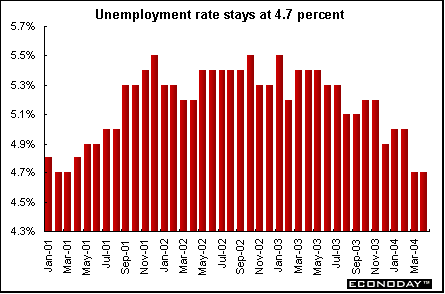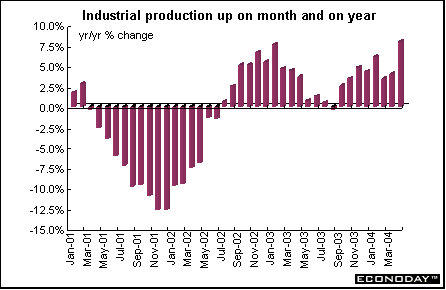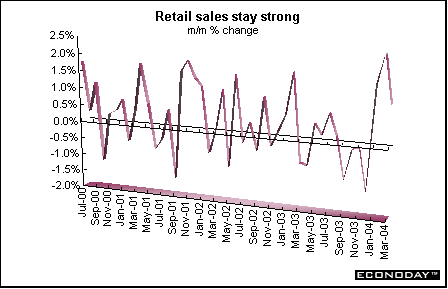Monday, May 31, 2004

Global Markets
Stocks were less volatile on a day-to-day basis this past week than they have been for several weeks. This was despite continued talk of escalating terrorism. But investors were mostly focused on oil prices and their impact on growth. Indexes rose and fell in concert with oil futures.
May wasn't kind to most stock indexes. With one trading day left, most markets are down on the month. And this despite a positive last week of trading. Stocks that have been particularly hurt include chemicals, which rely on crude for input in the manufacturing process, and airlines, which count fuels costs as a major expense that can hurt profits.
Global Stock Market Recap

Europe and Britain
Day-to-day changes were less pronounced last week in contrast to the volatility of recent weeks. On the week, the DAX and CAC were on the plus side despite Friday's declines. However, the FTSE edged down on the week. All three indexes were down in May. The FTSE has declined in three out of five months in 2004. Only the CAC remains above its end of 2003 level.

European stocks were depressed on Friday after the EMU harmonized index of consumer prices jumped by 2.5 percent, the highest rate in more than two years. This in turn stoked concern about the sustainability of an economic recovery not to mention the fading glimmer of hope for an ECB rate cut. Concerns hit the market that high energy prices and the prospects of increased interest rates in the U.S., Europe's largest trading partner, will worsen the outlook for corporate profits. Record energy prices and faster inflation may deter consumers from spending. Those industries whose sales are most tied to growth, such as technology and chemicals, were hardest hit.
Asia/Pacific
All six Asia/Pacific indexes righted themselves and finished on the positive side for the week. However, with one trading day left in May, the month is a decidedly mixed picture. The Hang Seng recouped over 5 percent of its recent losses but still remains below its 2003 year-end level. All five of the other regional indexes followed here (Japanese Nikkei and Topix, Singapore Straits Times, South Korean Kospi and Australian all ordinaries) are up on the year. May turned out to be a negative month for all Asian/Pacific indexes as the region's growth was called into question by higher crude prices. Japan, for example, imports virtually all of its oil supplies but has some price protection in its fuel supply contracts. And China's growing needs have put pressure on world supplies in general.

Japanese stocks rose after government reports on consumer spending and industrial production indicated that growth was spreading to the domestic economy as well. Until now, the economy was growing strictly thanks to exports. Investors have been waiting for increased consumer spending, which accounts for 55 percent of GDP, as a sign that growth could be more sustainable. Exporters such as Toyota gained as oil prices edged downward and U.S. GDP grew faster than initially estimated. The automaker generates about 80 percent of its operating profit from North America.
Currencies
Terrorism threats against the United States and oil price uncertainty only contributed to the building negative sentiment towards the dollar last week. The dollar weakened against most currencies after Attorney General John Ashcroft upgraded U.S. terrorism warnings. The dollar's recent slide accelerated on Thursday as soft U.S. economic data intensified fears that the market had factored in U.S. interest rates rising too far and too fast. Even a pullback in oil prices, with Nymex crude sliding to under $40, failed to reassure traders that the U.S. economy will grow fast enough to justify a doubling of overnight interest rates to 2 percent by year's end. The dollar's rally since February was predicated on rampant economic growth leading to rapid monetary tightening, leading speculators to liquidate dollar-funded carry trades. (Carry trades involve borrowing funds in a low interest rate country and then reinvesting it at a higher interest rate elsewhere to maximize returns.) Concerns that high oil prices could sabotage this rosy picture have weighed of late.

The yen strengthened to its highest level in three weeks against the dollar on a string of positive economic indicators that showed Japanese household spending rising at a record pace and industrial production posting an especially strong gain. (See indicator scoreboard below.) The yen advanced against the dollar after international investors bought a record amount of Japanese government bonds last week and the Japanese cut purchases of foreign stocks and fixed-income securities. Investors think the Japanese economy is on track to a full-fledged recovery, giving the currency more room to appreciate.
The euro continued to climb against the U.S. dollar despite dampened optimism among French manufacturers, but then fell back after the Chicago Purchasing Managers' business index climbed to a 16-year high.
Both the pound sterling and Swiss franc also gained against the dollar as did the two commodity currencies - the Australian and Canadian dollars. Sterling was aided by the CBI monthly trends survey showing manufacturing orders at their highest level since February 1998 and exports at their best in eight years.

Indicator scoreboard
EMU - March seasonally industrial orders jumped 1.5 percent and were up 12.1 percent when compared with last year. Textile and textile product orders combined with machinery and equipment to provide the boost. Orders were up in Portugal, France, Belgium and Germany while orders were down in Italy.
May Commission's economic sentiment index inched up to 100.3 from 100.2 in April. Improvement in the service sector more than offset declines in industry, consumer and retail sentiment. The economic sentiment index has been revised to include service sector confidence, so the new index is not comparable with the old. Industry confidence fell to minus 5 from minus 4 in April. The consumer confidence was down to minus 16 from the previously reported minus 14. Service sector sentiment, which was included in the index for the first time, climbed to plus 13 from plus 11 in April.
May flash harmonized index of consumer prices jumped to 2.5 percent when compared with the same month a year ago. The HICP was 2.0 percent in April on the year. In order to compute its HICP flash estimates, Eurostat uses early price information provided by Germany, Italy and - if available - by other member states, as well as information about energy prices.

M3 money supply growth for the three months ending in April was up 6.1 percent when compared with the same three months a year ago. This is a key indicator used by the ECB in its policy making process and remains well above the Bank's 4.5 percent target.

Germany - First quarter seasonally adjusted gross domestic product was up 0.4 percent and 0.7 percent when compared with the first quarter of 2003. Domestic demand was down but was offset by increased net exports.

May Ifo business sentiment index edged down to 96.1 from 96.3 in April. May's decline was due to a drop in current conditions to 94.4 from 94.9 in the previous month. Business expectations for the next six months inched up to 97.8 from 97.7 in the previous month.

France - April seasonally and calendar adjusted consumer spending on manufactured goods jumped 1.5 percent and 3.8 percent when compared with last year primarily due to increased sales of clothing and other goods. The gains more than offset declines in auto sales and household durables. Excluding auto and drug spending, sales were up 2.9 percent and 4.6 percent on the year.

April seasonally adjusted unemployment dropped by 10,000 but the unemployment rate remained at 9.8 percent for the third month. Recent labor market data continue to reflect more restrictive rules for unemployment insurance that ended benefits for some 180,000 long-term jobseekers at the start of the year.

April producer price index was up 0.4 percent and 1.3 percent when compared with last year. The core PPI, which excludes food and energy, was up 0.3 percent and 0.4 percent on the year. Prices were up primarily because of higher oil and metals prices. Energy prices jumped 0.8 percent and were 2.5 percent above prices of a year ago.

Britain - First quarter gross domestic production was up 0.6 percent and 3 percent when compared with last year. Growth in the service sector was partially offset with a decline in the manufacturing sector. Both household expenditure and gross capital formation were up on the quarter.

May Nationwide house price index jumped 1.9 percent and 19.5 percent when compared with last year. During the first five months of 2004 prices are up over 9 percent compared with slightly less than 6 percent in 2003.

Asia
Japan - April seasonally adjusted merchandise trade surplus narrowed to �985.5 billion ($8.81 billion) from a revised �1 trillion in March. From a year earlier, the trade surplus rose 30 percent to �1.08 trillion yen. Imports were up 1.1 percent while exports were up only 0.5 percent.

April employment was up by 240,000 jobs. The unemployment rate remained at 4.7 percent. Some employers are adding lower-cost part-time workers rather than hiring full-timers who receive pensions and medical benefits.

April seasonally adjusted spending by households headed by a salaried worker soared 9.3 percent and was up 7.2 percent when compared with last year. The jump follows a surprising 0.5 percent drop in the previous month. Wage earner spending is an important gauge of personal consumption, which accounts for roughly 55 percent of Japan's gross domestic product. The seasonally adjusted propensity for wage earners to consume, a ratio which measures the amount of disposable income that went to household spending, rose to 76.9 percent in April from 73.1 percent in March.
May Tokyo consumer price index edged up 0.1 percent but was down 0.3 percent when compared with the previous year. Tokyo core CPI, which excludes fresh food, was up 0.1 percent and down 0.1 percent on the year. The April CPI for all of Japan was unchanged on the month put dropped 0.4 percent on the year. Core nationwide CPI was up 0.2 percent but down 0.2 percent on the year.

April industrial production jumped 3.3 percent and soared 8.5 percent when compared with last year. The industries that contributed to the increase were transport equipment, electrical machinery and fabricated metals. Commodities (as defined by METI) such as large passenger cars, large trucks and personal computers also contributed to the jump.

Americas
Canada - March retail sales were up 1.2 percent after increasing 2.6 percent in February and 1.7 percent in January. Consumer spending increased by at least 1.0 percent in six of the seven retail sectors. Excluding sales by motor and recreational vehicle dealers, retail sales rose 1.0 percent in March. In constant dollars, retail sales rose 1.1 percent in March and 2.7 percent in the first quarter of 2004, an indication that sales growth was real and not inflated by higher prices.

April industrial product price index (IPPI) was up 0.8 percent and 1.5 percent when compared with April of 2003. Prices for motor vehicles and other transport equipment were up 0.8 percent primarily because of the exchange rate. Prices for primary metal products were up 1.7 percent because of increases for aluminum, nickel, iron and steel products. Lumber and other wood products increased by 2.3 percent because of increased demand.

The April raw materials price index (RMPI) slipped 0.2 percent but soared 8.4 percent when compared with last year. Mineral fuels were up 12.1 percent on the year with crude oil prices rising 17.5 percent. If mineral fuels had been excluded, the raw materials price index (RMPI) would have increased 5.5 percent. Prices for non-ferrous metals rose 38.5 percent from a year ago, mainly because of higher prices for copper, lead, zinc and nickel.
In April, the value of the U.S. dollar strengthened against the Canadian dollar with an increase of 1.1 percent. As a result, the total IPPI excluding the effect of the exchange rate would have risen 0.5 percent. However, on a 12-month basis, the Canadian dollar is much stronger. Consequently, excluding the effect of the exchange rate, the IPPI would have increased 3.6 percent rather than increasing 1.5 percent from April 2003 to April 2004.
Bottom line
Although U.S. markets are closed on Monday, the rest of the world will be busy with a full slate of economic indicators to digest. Typically the first week of the month is laden with new information for investors. The key PMI manufacturing and service indexes are released along with other key data.
Both the Reserve Bank of Australia and the European Central Bank will be meeting. It is doubtful that either will change their interest rates from 5.25 percent and 2 percent, respectively.
Looking Ahead: May 31 through June 4, 2004




